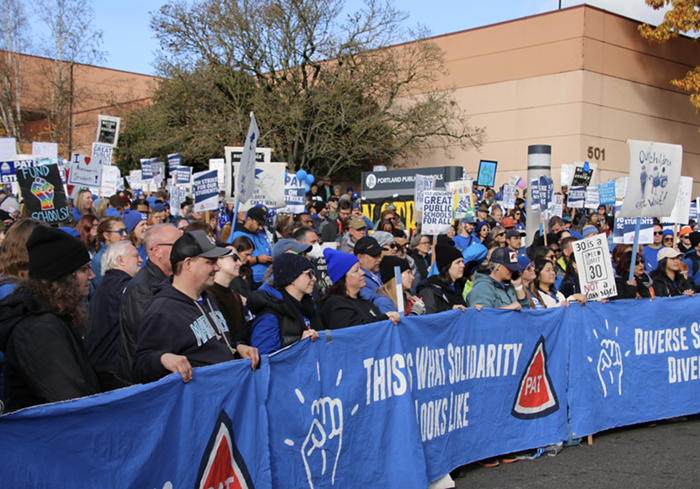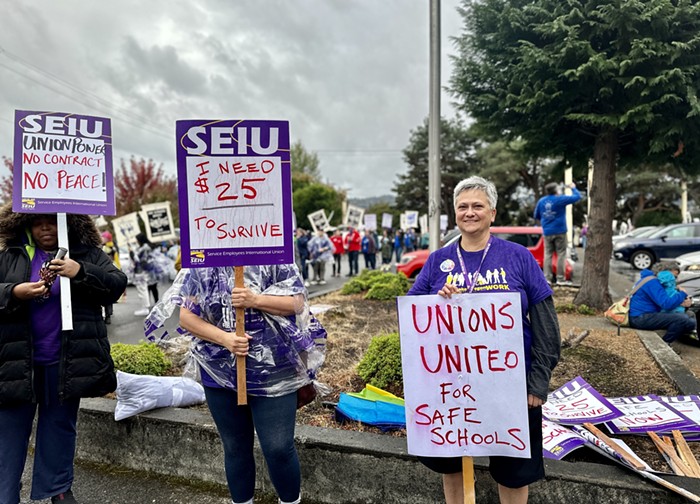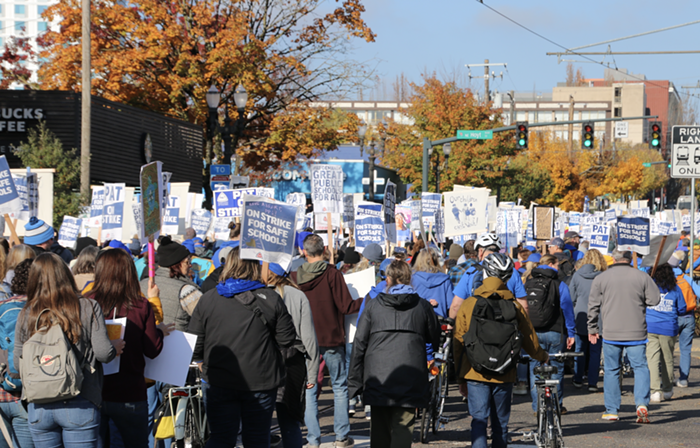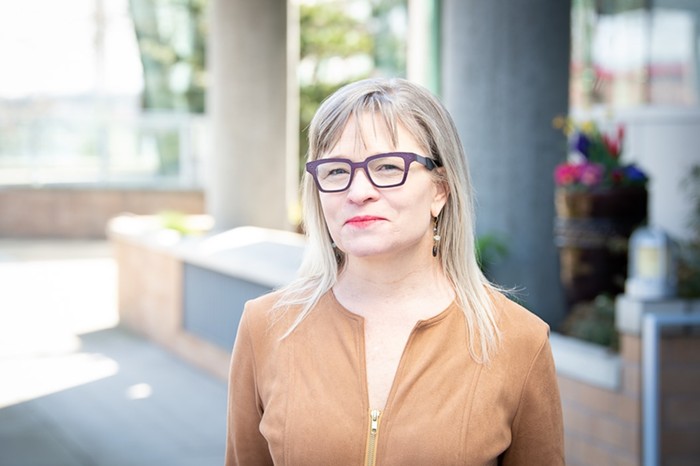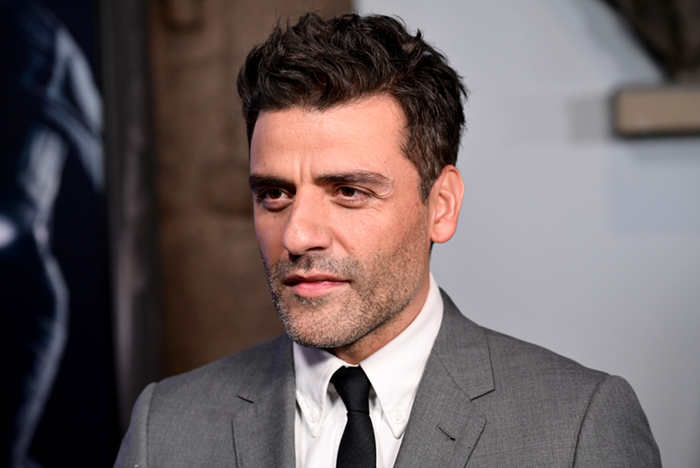To some, the recent Portland Public Schools (PPS) teachers’ strike was a “watershed moment” with big results. To others, the nearly-month-long strike was mishandled and left teachers, students, and other district stakeholders wanting more. Though recollections of the strike won’t fit neatly into a single narrative, it undeniably forced broader conversations about labor and statewide education funding.
Whether or not the new contract between PPS and PAT will be transformative for Portland’s teachers and students remains to be seen. The union didn’t get the pay bumps or limits on class sizes it initially fought for. Instead, PAT agreed to a nearly 14 percent cost of living adjustment over the next three years, and the district agreed to class size committees. And, much to the dismay of some students and families, PPS will cut the first week of winter break in order to make up for lost class time. But despite reports of acrimony within union leadership, many teachers have said they’re happy with the result.
If nothing else, the strike kicked off big conversations about— and potential changes to— how Oregon’s legislature allocates funding to public schools across the state. And the effects of the massive strike on the local labor movement are bound to reverberate for some time— especially as other unionized PPS employees enter stalemates with the district.
A “watershed moment”?
When news first broke about the tentative contract agreement between PAT and PPS last weekend, PAT President Angela Bonilla called the contract a "watershed moment for Portland students, families, and educators." Education labor leaders at the state and national levels were also eager about the terms of the contract.
Not every PAT member is so optimistic. Lincoln High School teacher Steve Lancaster, who served as the chair of the union’s bargaining team throughout the extended negotiations of the last year, resigned from his position in mid-November, prior to the union and district coming together on a contract agreement. According to the Oregonian, Lancaster told his colleagues he was “alarmed by what has clearly been an erosion of the strategic decision-making power and autonomy of the PAT bargaining team,” and that the “compromised democratic processes of the union have contributed to an unnecessarily long strike for the gains achieved.”

Other PAT members expressed concerns about the union’s assertion that the district could utilize a pot of state money it didn’t, in fact, have access to.
Thomas Rehm, a Jackson Middle School teacher, said he was “stunned by how little the teachers received in this new tentative deal.”
“My God, have we been duped? It was certainly was [a watershed moment], just in the opposite way in which Ms. Bonilla means,” Rehm wrote in a November 27 email to the Mercury.
During the lengthy bargaining process, teachers demanded action on two primary issues: class sizes and compensation. The final agreement does not include the class size caps teachers wanted, nor does it increase the added pay teachers receive if their class caseload exceeds a certain number of students. The main change to previous class size policy is the creation of class size committees, containing educators, administrators, and parents who will evaluate solutions in cases of excessive class size.
With regard to pay, the new contract offers raises of 13.8 percent over the next three years, about 3 percent higher than the district offered before the strike began. It’s the largest three-year cost of living adjustment (COLA) ever received in PAT’s history. But those COLAs are about 10 percent lower than what the union had in mind at the start of the strike.
Although the overwhelming majority of union members voted to ratify the contract, not everyone was elated by the agreement. As the strike continued, public pressure mounted for teachers to return to school— and since educators went back to work before the contract was ratified, a “no” vote would’ve meant going back on strike after many people believed it was over. Even Lancaster and others skeptical of union leadership encouraged members to vote in favor of the agreement.
Other teachers are more hopeful about what the agreement will yield.
Charity Powell is a member of PAT’s bargaining team and a special education teacher at Laurelhurst School. She told the Mercury that special education teachers, school psychologists, and speech language pathologists will have more manageable caseloads under the new contract agreement, allowing them to better serve their students.
Powell said one major change in the new contract allows students under evaluation for special education to be counted in teacher caseloads, which they couldn’t do previously. She said even though the teachers’ union didn’t manage to get class size caps in their contract, this will be a game-changer for many educators.
“Hopefully, over time, this will lead to PPS staffing us more appropriately so that we can better meet the needs of our students,” Powell said. “That feels like a really big win to me.”
Powell said another major boon in the new contract extends student instruction time in elementary and middle schools by 15 minutes per day, which gives students “an additional chunk of time… to work with [their] students.”
She also pointed to language in the new contract giving teachers increased planning time and more opportunities for professional development outside of the classroom.
“In creating more space for teachers to reflect on their practice and make adjustments…[it will allow us] to adjust and regroup and make a plan for meeting student needs moving forward,” Powell said.
Loren Chasse, a PPS 5th grade teacher, told the Mercury he thinks most of his colleagues are content with the contract agreement.
“There are teachers who are upset they didn’t get some piece they wanted [in the contract] for their particular situation. We’re always going to have that,” Chasse said. “My general feeling is teachers are happy. The bargaining team is made up of teachers who are in classrooms and are very much in touch with reality. There’s a lot of trust with the people representing us [in the union.]”
Other teachers say the blame for any community distrust that has resulted from the strike should be placed squarely on the shoulders of PPS administrators. Sam Balto, a physical education teacher at Alameda Elementary, said he was surprised to see PPS administrators publicly arguing with state legislators about the teachers’ strike. (On November 1, PPS Chief of Staff Jonathan Garcia called Rep. Travis Nelson’s support for teachers “performative” in a now-deleted tweet.)
“If the PPS administration talks to state legislators like this publicly, imagine what they say about PPS staff privately,” Balto said. “PPS leadership has caused a lot of harm and lost trust with the Portland community.”
Bonilla told the Mercury she acknowledges her educators had concerns immediately after the tentative agreement was signed, but said the concerns “came from a lack of information” and were mostly alleviated after a five-hour question and answer session ahead of the ratification vote. That conversation, Bonilla said, gave people “a better sense of why things ended up the way they did,” and an understanding that “this was the best deal we could have gotten under the circumstances.”
“My general feeling is teachers are happy. The bargaining team is made up of teachers who are in classrooms and are very much in touch with reality. There’s a lot of trust with the people representing us [in the union.]” -Loren Chasse, 5th grade teacher
Bonilla also said that it’s okay, even healthy, for organizations to be made up of people with different opinions and visions.
“I don’t mind folks being upset and feeling frustrated and having opinions. My only concern is that I hope they’re willing to listen with open minds and open hearts,” she said. “Organizing is not something that is one and done. Organizing is the act of building community by connecting with someone else around what they care about. And we’ve organized this entire city.”
The next step? Local and state leaders say it’s time for the Oregon legislature to examine how we fund public schools.
Oregon school funding
On November 28—the day the PPS board and teachers’ union both voted to ratify the new contract agreement— Governor Tina Kotek announced her plan to lead a statewide conversation about the problems at Oregon’s public schools. Kotek has suggested reforms like a statewide minimum teacher salary, improved mental health support for students, and a new Oregon Department of Education office focused on school budget transparency.
Bonilla said she was “elated” to see Kotek’s statement, and hopes the PPS strike will bring attention to the plights facing other public schools in Oregon. To PPS board members and district administration, though, Kotek’s words are inadequate and overdue.
At the November 28 meeting, PPS board member Andrew Scott— who was part of the district’s bargaining team during the strike— directed his frustration over “the last four weeks of disruption, acrimony, and lost learning time” at Oregon legislators and the governor.
“This strike is the result of Governor Kotek and the Democrat-controlled state legislature failing to do their jobs,” Scott said.
Throughout the bargaining process, district leaders said they wished they could fund all of the union’s requests. But that won’t be an option unless Oregon reforms its education funding structure.
In a November interview with the Mercury, PPS Communications Director Will Howell said the union’s demands were in line with the Quality Education Model— Oregon’s framework for funding a successful public education system. Each biennium, an 11-member Quality Education Commission presents their findings of best practices to guide Oregon’s education budget process. But the legislature doesn’t always heed their advice.
“The only way you could afford to [fund the teachers’ starting proposal] is if the state of Oregon provided a quality education level funding,” Howell said. “They’ve never done that and don’t seem inclined to.”
Howell said the extended and difficult bargaining process provided at least one benefit: The “opportunity to raise awareness of the deficiency in state funding.”
“[Public education in Oregon] has been on a slow decline since the early 1990s, when our anti-tax state passed a ballot measure that limited how much funds local school districts could raise,” Howell said. “You look at national rankings for state education, and Oregon is down there with the states we usually make fun of, like Mississippi and Alabama. You don’t want to be part of that club.”
At the November 28 board meeting, Scott said he was surprised that state legislators and Kotek “demanded [PPS administration] give our teachers the transformational contract they were asking for,” even though he thinks they should’ve known they didn’t have the budget for it. He was also surprised when PAT leadership allied with state legislators and defended the amount of public school funding the legislature allocated last year.
“There was a level of political gamesmanship that I did not expect,” Scott said. “It significantly set back any push for education funding reform, because it allowed our legislators to do what they do best: Pass insufficient budgets, then point at school boards and say ‘Do better.’” Scott pointed to the local option levy cap, which restricts how much money a school district can use from voter-approved property tax levies and reallocates funds above a certain threshold to other districts across the state, as a major problem in Oregon’s public school funding system.
He also said legislators need to look at reforming the tax kicker— a controversial state law that returns excess tax funds to taxpayers if revenues exceed the budget. For the 2021-23 biennium, OEA has confirmed a record-high kicker of more than $5.61 billion, which taxpayers will receive a portion of in their 2023 tax returns. Most of that will go back to the wealthiest Oregonians, and none will go toward funding any of the state’s departments, such as education.
“If we could harness just 50 percent of the anger that was directed towards the board over the last few weeks and redirect it towards the kicker, I guarantee you we'd have that thing overturned next year,” Scott said. “Never again will we let our legislators off the hook by begging for crumbs at the end of a legislative session.”
Teachers say they can address the issues with Oregon’s education funding system and continue to put pressure on PPS administration to rethink their spending.
“I think our [perspective] was that, yes, the state needs to do better,” Powell, the bargaining team member who teaches special education, told the Mercury. “And right now, PPS has money that they’re mismanaging.”
PAT members and union supporters— along with state legislators— have criticized PPS for administrative bloat. Analysis by the Oregon Department of Education shows PPS spent less on direct classroom expenditures, including spending on teacher salaries and benefits, relative to its total spending than other large districts around the state. Instead, PPS spent more on general administrative costs relative to peer districts.
“What if PPS invested the same amount relative to its total expenditures on direct classroom support as its peers? In 2021-22, if PPS invested the same relative percentage of its total spending as its peers, it would have invested an additional $43 million to $68 million in direct classroom expenditures,” the ODE report states.
“Never again will we let our legislators off the hook by begging for crumbs at the end of a legislative session.” -Andrew Scott, PPS school board
One area many PPS critics point to when criticizing the district’s spending: The district’s communications department, which has a $2.3 million budget, $1.8 million of which is allocated for personnel. For reference, the entirety of Creston Elementary School runs on a $2.5 million budget annually.
PPS says their new contract with PAT will require $130 million in budget cuts over three years. It’s unclear where the budget cuts will come from, but district leaders have said they’ll take a look at administrative spending.
What’s next for labor?
Other local labor groups are looking to the Portland teachers’ strike as an example of the power of community solidarity. The teachers’ strike was one of the largest labor actions to take place in the city in years, mobilizing thousands of people to come out in support of educators and unions.
Labor organizers point out that the strike has drawn attention to Oregon’s school funding woes and shifted the Overton window in favor of better working conditions for teachers and other school employees.
“Our public educators have moved the conversation forward toward fully funded public schools for all,” an email newsletter from labor organization Portland Jobs With Justice states. “Thanks to PAT for…fighting (like hell) for high quality teaching and learning environments, and for building a creative, joyous, and powerful labor community movement felt in every corner of the city.”
As PPS heads into later stages of bargaining with its other unions, workers will have the benefit of increased community awareness and employee solidarity on their side.

“[PAT] is the largest union in our district, so we understand the power that we have to give solidarity support to our partner unions,” Bonilla told the Mercury. “You can't have school without teachers, but you can't have safe, healthy, and clean schools without our Portland Federation of School Professionals or SEIU partners…we're going to put all our energy and solidarity behind their fight.”



